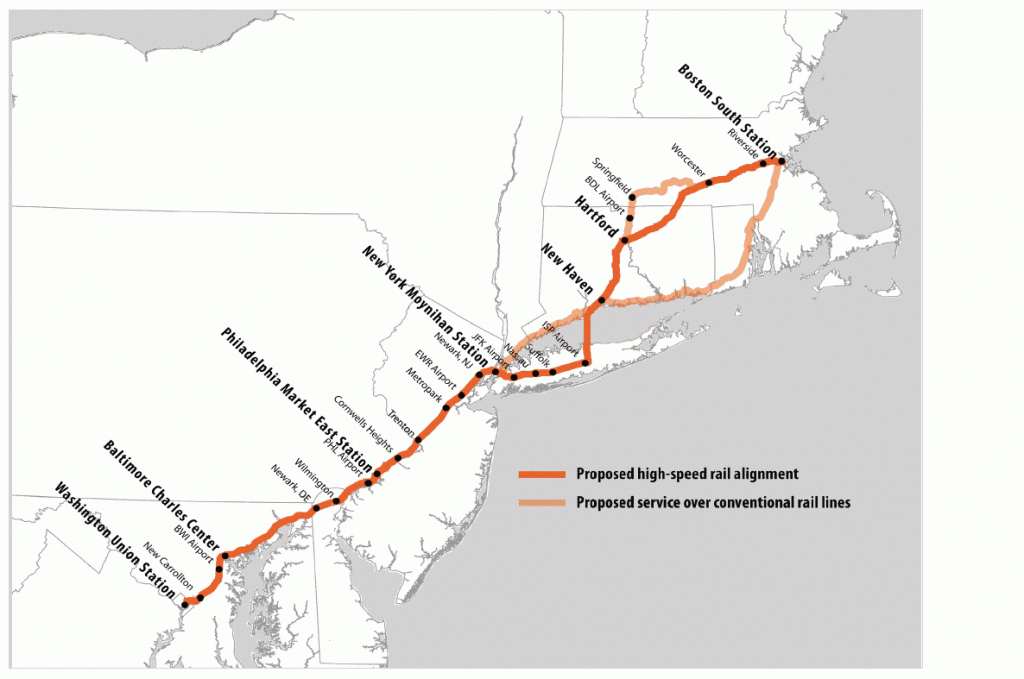UNIVERSITY OF PENNSYLVANIA HIGH-SPEED RAIL STUDIO
Executive Summary
High-speed rail is more than just a means of travel.
It is a powerful tool that can enable growth, achieve balance in a transportation system, and revitalize underperforming cities. It is the foundation upon which the Northeast Megaregion of the United States will shape its destiny in the coming years.
The Northeast Megaregion extends from Maine to Virginia and is the economic powerhouse of the nation. It is home to 50 million residents and has a $2.6 trillion economy focused along the dense Northeast Corridor from Boston to Washington. By 2050, the Northeast is predicted to grow by an additional 20 million residents, which has the potential to generate enormous economic growth.
This growth is threatened, however, by the strained capacity of the Northeast’s infrastructure systems. Congested and deteriorating from years of deferred maintenance, the highways, runways, and rail lines of the Northeast cannot meet the needs of the future. There is also little room to build upon these existing systems, with highways that run through dense urban areas and airspace that is almost completely full.
The success of the United States has always depended on mobility. Without investments in canals, railroads, highways, and runways, this vast country would never have realized its creative and productive potential. In 2010, a group of researchers from the University of Pennsylvania’s School of Design presented a visionary plan to meet the Northeast’s mobility needs through a new mode: High-speed rail.
The 2010 PennDesign plan proposed a high-speed rail (HSR) system that would run on its own dedicated tracks, which would allow it to provide unprecedented reliability and freedom of movement. This proposal paved the way for Amtrak to release its own “Next Generation” high-speed rail plan for the Northeast. High-speed rail has the potential to link economies, regenerate regions, and provide new opportunities for millions of Americans. Many of America’s global competitors have embraced high-speed rail, from the European Union to Russia, Brazil, and Saudi Arabia, and some have made these systems centerpieces of their economic growth strategy. The United States risks falling behind if it does not invest in 21st Century infrastructure.
It is not enough to build high-speed rail because the rest of the world is doing so. There must be compelling reasons to build high-speed rail in America, now. The Northeast Megaregion, with a population density of over 8,200 persons per square mile and a portfolio of high-value knowledge-based industries, is uniquely positioned to benefit from high-speed rail. The Northeast’s cities are a “string of pearls” that span evenly along the 457-mile corridor, which is well within the ideal range of any HSR system. Among these cities are economic generators and places with unmet economic potential that will grow together with the aid of frequent, reliable connections. The Northeast features a culture of rail ridership, surging population growth, and a large demand for inter-city travel that cannot be met by current modes.
The Penn proposal of 2010 described in broad strokes what high-speed rail in the Northeast Megaregion could look like and why it is needed. The proposed system extends from Washington to New York along the existing rail corridor before moving eastward along Long Island and traveling through a new tunnel to New Haven, Hartford, and Boston.
Download full version (PDF): High-Speed Rail in the Northeast Megaregion
About the University of Pennsylvania High-Speed Rail Studio
www.design.upen.edu/hsr2011
“The University of Pennsylvania high-speed rail studio, now in its second year, comprises a group of second-year city planning students from a variety of academic concentrations: urban design, environmental planning, public-private development, and transportation. While last year’s studio described what a high-speed rail system in the northeast would look like, our ambitious goal this year is to illustrate in detail how HSR would serve communities in the megaregion. Specific areas of research include the institutional and financial structure of organizations responsible for HSR’s implementation, station area design and economic development planning, and intermodal connectivity for regional integration. Our work, guided by PennDesign Dean Marilyn Jordan Taylor and Professor of Practice Bob Yaro, will be informed by site visits to European case studies and a week-long charette workshop in Madrid with HSR experts from the U.S. and around the world. Our final product will be presented to U.S. transportation officials in May, as well as made available to the general public.”
Tags: HSR, Northeast, Northeast Megaregion, University of Pennsylvania, University of Pennsylvania High-Speed Rail Studio, University of Pennsylvania School of Design, UPENN







 RSS Feed
RSS Feed